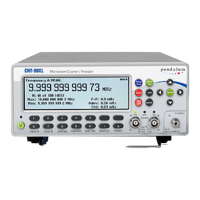— Press SETTINGS
STAT and set No.of
samples to 1000 or more.
— Press
Meas Time and select a low value.
Press
STAT/PLOT and watch Δf
p-p
.
Δf
p - p
= f
max
- f
min
= 2 x Δf.
Errors in fmax, f min, and Δfp-p
A measurement time corresponding to 1/10cy-
cle, or 36° of the modulation signal, leads to an
error of approx. 1.5%.
Select the measurement time:
Error when determining f
max
To be confident that the captured maximal fre-
quency really is fmax, you must select a suffi-
ciently large number of samples, for instance n
AM Signals
The counter can usually measure both the car-
rier wave frequency and modulation
frequency of AM signals. These measurements
are much
like the burst measurements described earlier
The carrier wave (CW) is only continuously
present in a narrow amplitude band in the
middle of the signal if the modulation depth is
high. If the sensitivity of the counter is too low,
cycles will be lost, and the measurement
ruined.
Fig. 4-8 Effects of different sensitivity when
measuring the CW Frequency of an
AM signal.
To measure the CW frequency:
Select a measurement time that gives you
the resolution you want.
Turn on
Manual trigger.
Press
Trig level and enter 0 V trigger level
(press the numeric key 0 and EXIT/OK).
Select 1x attenuation to get a narrow hys-
teresis band.
If the counter triggers on noise, widen the
hysteresis band with the 'variable hyster-
esis' function, i.e. enter a trigger level >0 V
but <V
P-Pmin. See Fig. 4-8.
USER MANUAL ● CNT 9x Series ● Rev.22 February 2020
4-8

